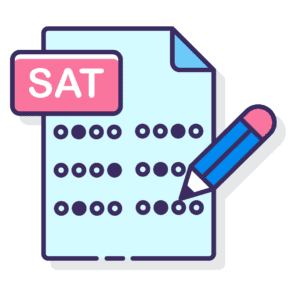Do you have a love-hate relationship with the SAT like many college bound students and their parents? Parents love to say their student achieved a high score on the SAT. But students hate the hours of prep work spent studying for the test, and then actually spending 3 hours taking it.
Students who aren’t good test takers hate that the SAT doesn’t measure their actual knowledge and intelligence. But families love when their students get accepted to school or offered scholarships based on their SAT score.
No matter how you feel about the SAT, it’s important to know about new digital SAT, what’s changing, and how it will impact your high schooler.
 What are the SAT changes?
What are the SAT changes?
The biggest change is that instead of a paper and pencil SAT, the new version will be computer based and taken on a laptop or tablet using the new testing app, Blue Book App, which will need to be downloaded on the device before the test.
The app will have a built in calculator available for all math questions. Reading passages will be shorter and there will be more of them. The length of the test will change as well, going from a three hour test to just over two hours long.
The digital SAT is composed of two sections, a reading and writing section, and a math section. Each section is divided into 2 equal length modules. The second module of each section will adapt to the student’s performance on the first module. This means if a student struggled in module one of math, module two may be less difficult. But if they excelled in the first reading and writing module, then the second module will adapt and be more challenging.
Even though the test will no longer be on paper, students will be allowed to use pencil and paper to solve problems or make notes while they are working through questions. (Or doodle if they finish early)
The digital test will be offered more often than the current paper test, and the results should be available within days instead of weeks.
When are the changes taking place?
The changes have already begun. Starting in 2023, international students began taking the digital version.
In the fall of 2023, the PSAT will be offered to US students in a digital format. By taking the digital form of the PSAT in the fall, Juniors will get a practice run at the new test. As of January 2024, all US students will take the SAT digitally.
What will the effect of these changes be?
Depending on your perspective, these changes may be good, bad or indifferent. Filling out little bubbles on a piece of paper was always a pain for me personally, but, on the flip side, there’ll be no more opportunity to draw Christmas trees on your answer sheet. There will also be no opportunity to accidentally get off track with what question number you are on and have to go back and erase an entire section and fill it out again.
Students with vision problems may find it easier or harder to look at a computer screen vs a sheet of paper.
Students experiencing difficulty with sitting and concentrating for long periods of time may benefit greatly from the shorter exam.
Students may find it easier to comprehend and answer questions on shorter reading passages.
The test is not meant to be easier or harder and digital scores should be comparable to their pencil and paper counterparts.
Having the test offered more often with faster results should give students more opportunities to improve their score when time is running short before college applications are due.
How can students prepare for the digital SAT?
The College Board offers a couple of ways to help students prepare for the SAT at no cost.
- Khan Academy Partnership – Students can use their Khan Academy account to get practice in specific areas covered by the SAT exam
- Blue Book App – The application that delivers the test itself also allows students to practice for the exam, including full length practice tests
 Tell me more about the history of the SAT
Tell me more about the history of the SAT
The SAT, formally known as the Scholastic Aptitude Test, is a standardized test used by colleges and universities in the United States as part of the admissions process. It was first introduced in 1926 by the College Board as a way to measure critical thinking and problem-solving abilities of students applying to college.
At first, the SAT was called the Scholastic Aptitude Test, and it consisted of two sections: verbal and math. Over the years, the SAT has undergone several changes in format and scoring.
In 1994, the name of the test was changed to the Scholastic Assessment Test, and then in 2005, it was changed again to the SAT Reasoning Test. In 2016, the College Board launched a new version of the test, which included changes such as removing obscure vocabulary words and placing a greater emphasis on real-world problem-solving. Today, the SAT is one of the most widely used college admissions tests in the United States, with millions of students taking the test each year.
Do I even need to take the SAT?
While it is true that some colleges no longer require you to submit test scores as part of your application, many others continue to ask for either SAT or ACT test scores. Also, strong test scores may help you get outside or state sponsored scholarships as well. If you are someone who doesn’t test well, consider applying to some test optional schools as part of your college planning strategy.
Hopefully, taking the new digital SAT will be a positive change for students. I, personally, would have preferred to point and click rather than fill in hundreds of little bubbles. And I sincerely doubt that anyone will complain about it being an hour shorter.
Stay tuned to see how the roll out goes in the coming months. Thanks to the international students taking it digitally in 2023, the experience here in the US should run smoothly in 2024.



